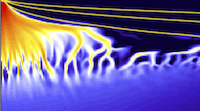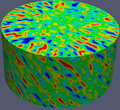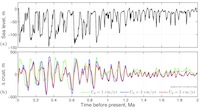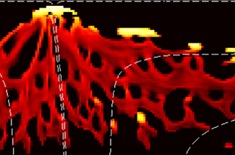THIS PAGE IS FAR OUT OF DATE! APOLOGIES!
Carbon and water-induced melting and thermal transport in subduction zones. Funded by a NERC consortium grant with supplementary from the Deep Carbon Observatory of the Sloan Foundation, this project seeks to apply the theory of magma/mantle dynamics with full thermochemical consistency to subduction zones. These settings are complicated by the influx of water and carbon-rich liquids from the subducting slab below. Development will include an open-source simulation code based on PETSc and available for community use.
People: May, Rees Jones, Rudge, Tian & Katz.
 Volatile-enriched melting and melt transport through the mantle beneath mid-ocean ridges. Funded by a Starter Grant from the European Research Council, we are developing computational and simple, analytical models of the effects of CO2 and H2O in the melting regime beneath mid-ocean ridges. One aspect is to predict variations in the emission of carbon from the global mid-ocean ridge system as a function of time, driven by inter/glacial changes in sea level. The other aspect is development of a three-component (olivine-basalt-volatiles) thermochemical model of melting and coupling of that model into simulations of magma/mantle dynamics beneath a ridge axis.
Volatile-enriched melting and melt transport through the mantle beneath mid-ocean ridges. Funded by a Starter Grant from the European Research Council, we are developing computational and simple, analytical models of the effects of CO2 and H2O in the melting regime beneath mid-ocean ridges. One aspect is to predict variations in the emission of carbon from the global mid-ocean ridge system as a function of time, driven by inter/glacial changes in sea level. The other aspect is development of a three-component (olivine-basalt-volatiles) thermochemical model of melting and coupling of that model into simulations of magma/mantle dynamics beneath a ridge axis.
People: Keller, Turner, Burley & Katz.

Consequences of anisotropic viscosity for melt segregation in partially molten rocks. We are exploring the consequences of a theory for anisotropic viscosity, derived by Professor Y Takei of the University of Tokyo. The theory is based on the microscopic distribution of melt around the boundaries of solid grains in a partially molten rock. Deviatoric stresses cause this distribution to be anisotropic, and this leads to preferential directions for deformation of the aggregate. We are developing analytical and numerical solutions to elucide the behaviour of the equations, and we are exploring their predictions for magmatic segregation in laboratory experiments and in the partially molten mantle.
People: Katz, in collaboration with Y Takei (Earthquake Research Institute).
 Computational tools for magma dynamics of subduction zones: finite element models and efficient solvers. In this project, funded under NERC standard grant NE/I026995/1, we will develop computational tools for coupled magma/mantle dynamics, with special consideration of subduction zone magmatism. Magma genesis in subduction zones is an open-system, reactive process—it depends on the inflow of a volatile-rich fluid from the slab, as well as the inflow of high-temperature rock from the ambient mantle. We still have little understanding of the process by which slab fluids and mantle rock mingle and react within the wedge. This omission is due to the complexity of the two- phase, open-system, reactive fluid mechanics and thermodynamics that control the system. This project will use interdisciplinary collaboration to develop a next-generation finite-element-based computational simulator—one that incorporates coupled fluid/magma/mantle flow, reactive melting, and thermal transport within the wedge.
Computational tools for magma dynamics of subduction zones: finite element models and efficient solvers. In this project, funded under NERC standard grant NE/I026995/1, we will develop computational tools for coupled magma/mantle dynamics, with special consideration of subduction zone magmatism. Magma genesis in subduction zones is an open-system, reactive process—it depends on the inflow of a volatile-rich fluid from the slab, as well as the inflow of high-temperature rock from the ambient mantle. We still have little understanding of the process by which slab fluids and mantle rock mingle and react within the wedge. This omission is due to the complexity of the two- phase, open-system, reactive fluid mechanics and thermodynamics that control the system. This project will use interdisciplinary collaboration to develop a next-generation finite-element-based computational simulator—one that incorporates coupled fluid/magma/mantle flow, reactive melting, and thermal transport within the wedge.
People: Rhebergen, Wathen, & Katz. Collaboration with J. Rudge, G. Wells, & L. Alisic (Cambridge).
 Ice ages, Sea level, and Magmatism: Coupled Oscillations. In this project, funded by a European Research Council grant, we intend to explore the link between ice ages, which cause sea-level variations of more than 100 metres, and mid-ocean ridge magmatism. Melting beneath mid-ocean ridges is sensitive to pressure; small changes in pressure cause small variations in the melting rate. Because a sea-level change affects pressure throughout the melting region, these small changes can add up to observable variations in crustal thickness. There may also be consequences for trace-element geochemistry of lavas. The FoaLab will develop and use PDE-based computational models to quantify these predictions. We will collaborate to compare these predictions with measurements.
Ice ages, Sea level, and Magmatism: Coupled Oscillations. In this project, funded by a European Research Council grant, we intend to explore the link between ice ages, which cause sea-level variations of more than 100 metres, and mid-ocean ridge magmatism. Melting beneath mid-ocean ridges is sensitive to pressure; small changes in pressure cause small variations in the melting rate. Because a sea-level change affects pressure throughout the melting region, these small changes can add up to observable variations in crustal thickness. There may also be consequences for trace-element geochemistry of lavas. The FoaLab will develop and use PDE-based computational models to quantify these predictions. We will collaborate to compare these predictions with measurements.
People: Keller, Turner, Burley, & Katz. Collaboration with C. Langmuir and P. Huybers (Harvard).

Consequences of mantle heterogeneity for the mechanics and energetics of magmatism beneath mid-ocean ridge. We use theoretical models based on conservation of mass, momentum, and energy to investigate coupled magma/mantle flow and melting/freezing beneath a mid-ocean ridge. We are particularly interested in the consequences of chemical and lithologic heterogeneity. Our results suggest that mantle heterogeneity modifies the dynamics of both magma and mantle flow, and the melting behaviour, relative to predictions from models that assume a homogeneous mantle. This difference may help us to understand geological observations of ophiolites, geochemical measurements of lavas dredged from the sea-floor, and marine geophysical observations of the sea floor.
People: Weatherley, Rudge, Katz.
 Coupled dynamics of ice sheets and subglacial hydrology. In many regions of the Antarctic ice sheet, temperatures at the bottom of the ice are at the freezing point, and high-pressure liquid water coexists with glacial ice. This water may soften the subglacial till, or hydraulically lift the glacier to reduce friction at the bed, allowing for rapid sliding of the ice. Sliding and shearing of the ice may, in turn, generate more melt-water through dissipative heating. There is some evidence that this feedback is important to the development of ice streams, which carry a dominant fraction of the Antarctic efflux of ice into the sea. We are developing theoretical models and numerical simulations to investigate the consequences of coupling between the ice sheet and its subglacial hydrologic system. This theory will incorporate thermodynamic and frictional interactions between the water and ice. Our goal is to better understand the dynamics of ice streams, and to make accurate predictions about how they will adjust to a warming climate.
Coupled dynamics of ice sheets and subglacial hydrology. In many regions of the Antarctic ice sheet, temperatures at the bottom of the ice are at the freezing point, and high-pressure liquid water coexists with glacial ice. This water may soften the subglacial till, or hydraulically lift the glacier to reduce friction at the bed, allowing for rapid sliding of the ice. Sliding and shearing of the ice may, in turn, generate more melt-water through dissipative heating. There is some evidence that this feedback is important to the development of ice streams, which carry a dominant fraction of the Antarctic efflux of ice into the sea. We are developing theoretical models and numerical simulations to investigate the consequences of coupling between the ice sheet and its subglacial hydrologic system. This theory will incorporate thermodynamic and frictional interactions between the water and ice. Our goal is to better understand the dynamics of ice streams, and to make accurate predictions about how they will adjust to a warming climate.
People: Kyrke-Smith, Fowler, Katz.
